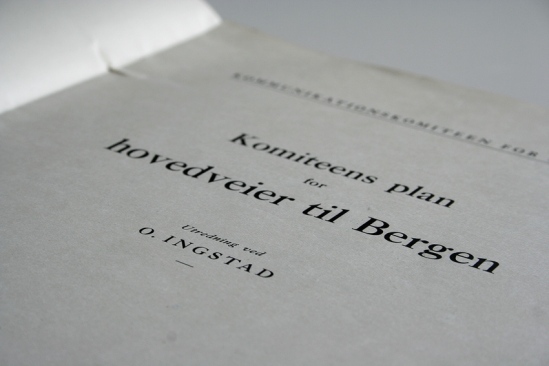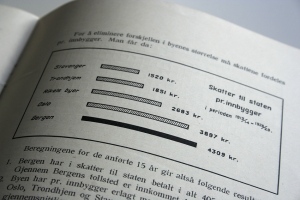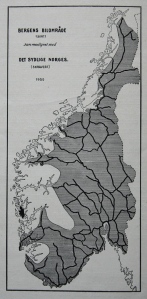“Plan for hovedveier til Bergen” (Plan for main roads to Bergen)
A book in hindsight, 80 years on.
By Ketil Svendsen
 If you consider making a road movie, capturing the beauty of west coast Norway coupled with hilarious, absurdist road action, you need not make it a widescreen one.
If you consider making a road movie, capturing the beauty of west coast Norway coupled with hilarious, absurdist road action, you need not make it a widescreen one.
 (The first part is the needed background info for foreigners; click here if you’re born and bred in Bergen). Let’s move back in time a bit, before Thelma & Louise, before cars, before Oslo became the drain in the monetary sink of Norway … From the end of the Viking era, until 1314, Bergen was the capital of Norway. Always the shipping nation, Norway’s premiere fjord city was also the main port of international commerce. Bergen had the King, the power and the money until, as mentioned, 1314.
(The first part is the needed background info for foreigners; click here if you’re born and bred in Bergen). Let’s move back in time a bit, before Thelma & Louise, before cars, before Oslo became the drain in the monetary sink of Norway … From the end of the Viking era, until 1314, Bergen was the capital of Norway. Always the shipping nation, Norway’s premiere fjord city was also the main port of international commerce. Bergen had the King, the power and the money until, as mentioned, 1314.
Bad year, then. While with the power lost to the flat farmlands of eastern Norway, the city remained the largest, capita-wise, well into the 1830s. Shipping, trading, fisheries and later on fossil fuel, has made the west coast provide every hair dresser, broker, nail designer, paper mover and politician in Oslo a steady income ever since.
With all this wealth produced, you might imagine the streets of Bergen being lined with leaf gold, the result of the vast amount of money being returned from Oslo, keeping the nation’s most important infrastructure up to date? No? Been visiting us by car, you say —
It’s a sad story. Every other year (and inside every car, every day) a debate on the west vs east infrastructure politics rises. The western roads are mad, bad and downright dangerous. Narrow strips of cracked asphalt, framing the fjords like grey, rotten spaghetti. Every day death, damages and delays waiting behind the next curve. Oh, and there’s heavy toll to be paid, driving on these damaged structures …
Some of the best stretches were made with involuntary man power during the last war, and you get the feeling it’d take another world war to repair the rest. If necessary repair are being done, you can bet it’s either road toll financed or — lo and behold — government funds orchestrated with complaints from concerned Oslo citizens, asking why a rough path should be upgraded in the west, all while they ‘still haven’t got another bloody road on top of last year’s brand new motorway?’.
 There you go: the needed, basic sociohistorical background … And this is where we get to the subject of this article.
There you go: the needed, basic sociohistorical background … And this is where we get to the subject of this article.
Before the war, the main issue wasn’t the width and quality of the road, it was length. In 1931, a group of concerned citizens — this time big names of Bergen commerce — did the groundwork for a dearly needed plan for upgrading the infrastructure along the coast. Whilst modern roads tied northern, mid and southern Norway together with capital Oslo, Bergen had per 1931 no such tie — apart from the 1909 railroad and coastal waters. The outbound roads from Bergen stretched as far as the suburbs of nowadays: some 30 kilometers, built a hundred years back (a hundred years was a lot in those days). Compared with a rough 10.000 kilometers of Norwegian road surface been built since 1825, the people of Bergen were getting restless …

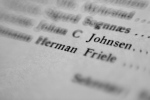 Enter a seven-strong group of prominent heavies, ranging from mayor R. J. Lorentzen, through various notabilities of Bergen commerce, to big time coffee factory founding father Herman Friele — still alive today, as he was in 1763 and as he was while mayor of Bergen from 2003-2007. He’s our Christopher Walker, you could say …
Enter a seven-strong group of prominent heavies, ranging from mayor R. J. Lorentzen, through various notabilities of Bergen commerce, to big time coffee factory founding father Herman Friele — still alive today, as he was in 1763 and as he was while mayor of Bergen from 2003-2007. He’s our Christopher Walker, you could say …
“Kommunikationskomiteen for Bergen: Komiteens plan for hovedveier til Bergen — Utredning ved O. Ingstad” (The communications committee for Bergen: The committee’s Plan for main roads to Bergen — Research by O. Ingstad [former city engineer]) stressed the fact that Bergen by the late 20s was falling behind the expected growth in both population and economy, mainly due to lack of communication with the rest of the country. No roads, no trade.
Facts and figures, maps and photographs all told the grim truth: Bergen was further from Oslo than ever before. A telling map shows the spider web of roads leading to and from Oslo; with Bergen as a lone, passing fly. Would it ever be caught in the net? Statistics further pinned down the fact that Bergen was topping every list concerning merchant fleet, income, taxes — while being left behind when it came to infrastructure. The Plan was thus a friendly way of telling Oslo not to take aim at the supporting legs and pull the trigger.
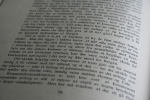 The projects being built and planned for the west coast were fractioned, and they all led the traffic outwards, never leading into Bergen. The communications committee for Bergen (that’s the seven heavies) debates three main road projects, leading traffic not only unhindered along the coast (and even eastwards) but most importantly through Bergen. An overall plan to keep the fuel coming and the engine of the region running.
The projects being built and planned for the west coast were fractioned, and they all led the traffic outwards, never leading into Bergen. The communications committee for Bergen (that’s the seven heavies) debates three main road projects, leading traffic not only unhindered along the coast (and even eastwards) but most importantly through Bergen. An overall plan to keep the fuel coming and the engine of the region running.
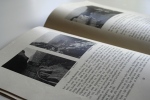
 The chosen paths of wheeled delights took into consideration the existing roads, and took benefit from their connection with the steam vessels and ferries.
The chosen paths of wheeled delights took into consideration the existing roads, and took benefit from their connection with the steam vessels and ferries.
Some suggestions never saw the light of day (as with the road from Haugsdal to Samnanger — although a path does exist, as an old military connection), some were built during the war, some only recent (Trengereid—Voss was an alternative route to the Trengereid—Eide/Granvin one, and the coastal road extravaganza heading south was finished within the ironic 90s) — and some are still in debate: still no railway to Haugesund …
So, what can we learn from this glimpse into ancient west/east struggle? It’ll never end. These days media are still full of politicians wondering why traffic security should be an issue outside Oslo, Oslo based “national” newspapers headlining traffic jams inside Oslo — and local papers outside Oslo running tragic stories of people being killed by avalanches/falling rocks/other cars, villages being isolated, roads closed. Often deemed “too local” for the Oslo press.
In the 70s major west coast newspaper Bergens Tidende ran a full front page on the bad weather situation (all roads closed, the Bergen—Oslo train off the rails, storm at sea etc), stating: “Eastern Norway isolated”.
We shall prevail.

